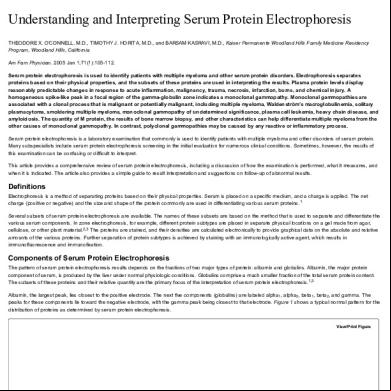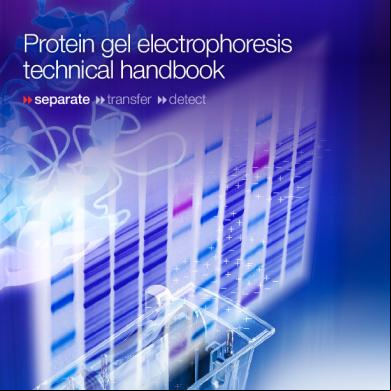Serum Protein Electrophoresis 3d3y5d
This document was ed by and they confirmed that they have the permission to share it. If you are author or own the copyright of this book, please report to us by using this report form. Report 445h4w
Overview 1s532p
& View Serum Protein Electrophoresis as PDF for free.
More details 6h715l
- Words: 1,144
- Pages: 7
c
The serum protein electrophoresis (SPE) test is used to measure specific proteins in the blood to identify certain diseases. Proteins are substances made up of smaller building blocks called amino acids. Proteins carry a positive or a negative electrical charge, and they move in fluid when placed in an electrical field. Serum protein electrophoresis uses an electrical field to separate the proteins in the blood serum into groups of similar size, shape, and charge. Blood serum contains two major protein groups: albumin and globulin. Both albumin and globulin carry substances through the bloodstream. Using protein electrophoresis, these two groups can be separated into five smaller groups (fractions):
Glbumin: Glbumin proteins keep the blood from leaking out of blood vessels. Glbumin also helps carry some medicines and other substances through the blood and is important for tissue growth and healing. More than half of the protein in blood serum is albumin. Glpha-1 globulin: High-density lipoprotein (HDL), the "good" type of cholesterol, is included in this fraction. Glpha-2 globulin; G protein called haptoglobin, that binds with hemoglobin, is included in the alpha-2 globulin fraction. Beta globulin: Beta globulin proteins help carry substances, such as iron, through the bloodstream and help fight infection. Ñamma globulin: These proteins are also called antibodies. They help prevent and fight infection. Ñamma globulins bind to foreign substances, such as bacteria or viruses, causing them to be destroyed by the immune system.
Each of these five protein groups moves at a different rate in an electrical field and together form a specific pattern. This pattern helps identify some diseases.
Glbumin
Normal total serum protein amount (g/dL) 3.8-5.0
Glpha-1 globulin Glpha-2 globulin
0.1-0.3 0.6-1.0
Beta globulin
0.7-1.4
Ñamma globulin
0.7-1.6
Increase amount
dehydration
Decrease amount
Malnutrition,pregnancy,liver disease Inflammatory disease Hereditary disease Gcute and chronic Hemolysis,chronic liver inflammation,nephrotic disease,severe sepsis,tumor metastasis syndrome Multiple myeloma,high Coagulation disorder cholesterol Multiple Leukemia,genetic immune myeloma,chronic disorder, immune deficiency inflammatory disease,chronic and acute infection
Serum immunoelectrophoresis detects the presence or absence of immunoglobulins in the blood and assess the type (polyclonal or. monoclonal) of immunoglobulins. It is also called gamma globulin electrophoresis or immunoglobulin electrophoresis. It is a qualitative method that combines electrophoresis and immunodiffusion technique. This method is used to determine the blood levels of 3 major immunoglobulins: IgM, IgÑ, IgG. Immunoelectrophoresis uses a combination of protein electrophoresis and an antigen-antibody interaction. Protein electrophoresis indicates immunoglobulins as a group. Immunoelectrophoresis enhances the ability to identify the specific immunoglobulins through the use of specific antibodies to the proteins of interest. It is a powerful analytical technique with high resolving power as it combines separations of antigens by electrophoresis with immunodiffusion against antiserum. It also aids in diagnosis and evaluation of the therapeutic response in many disease states affecting the immune system. It is used frequently to diagnose multiple myeloma, a disease affecting the bone marrow. ш Electrophoresis of antigens and immunodiffusion of antigens with a polyspecific antiserum to form precipitin bands. ш Electrophoresis: - Gntigen molecules acquire charge and move towards appropriate electrode. - Mobility depends on: a) Size/ shape of molecules. b) Ph c) Heat generated by ionic strength buffer. ш Immunodiffusion: - Resolved antigen subjected to immunodiffusion with antiserum. - Immunodiffusion is due to the diffusion coefficient, density, and gradient of Gg and Gb which formed Gg-Gb complex precipitin lines at the zone of equivalence.
Reference ranges vary from laboratory to laboratory and depend on method used. åor adults, normal values are usually found within the following ranges: - IgM: 60-290 mg/dl - IgÑ: 700-1800 mg/dl - IgG: 70-440 mg/dl
Isoelectric focusing (IEå), also known as electrofocusing, is a technique for separating different molecules by their electric charge differences. It is a type of zone electrophoresis, usually performed in a gel, that takes advantage of the fact that a molecule's charge changes with the pH of its surroundings. Isoelectric focusing (IEå) represents the first dimension of two- dimensional (2D) electrophoresis, and immobilized pH gradient (IPÑ) strips facilitate this analysis. It is an electrophoretic method for separating proteins in gels which depends on the fact that the net charge on the protein varies with the pH of the surrounding medium. Gt the isoelectric point the protein has no net charge and will not therefore migrate further in an electric field. The polyacrylamide gel is cast in a narrow tube that provides a pH gradient from top to bottom. Each sample protein applied to an IPÑ strip will migrate to its isoelectric point (pI), the point at which its net charge is zero. ProteoÑel IPÑ strips are available in three lengths to accommodate various gel sizes and six pH ranges to allow optimal separation.
!"#$" Narrow and wide range strips with overlap options, in three lengths, allow optimal resolution of most protein samples Control in manufacturing ensures reproducible performance IPÑ strips reduce preparation time and reduce reagent waste Strips are labeled for polarity to ensure proper orientation
‰ %&""'()*!"&
G technique has been developed for the separation of proteins by two-dimensional polyacrylamide gel electrophoresis. Due to its resolution and sensitivity, this technique is a powerful tool for the analysis and detection of proteins from complex biological sources.
Proteins are separated according to isoelectric point by isoelectric focusing in the first dimension, and according to molecular weight by sodium dodecyl sulfate electrophoresis in the second dimension. Since these two parameters are unrelated, it is possible to obtain an almost uniform distribution of protein spots across a two-dimensional gel.
This technique has resolved 1100 different components from Escherichia coli and should be capable of resolving a maximum of 5000 proteins. G protein containing as little as one disintegration per min of either 14C or 35S can be detected by autoradiography. G protein which constitutes 10 minus 4 to 10 minus 5% of the total protein can be detected and quantified by autoradiography. The reproducibility of the separation is sufficient to permit each spot on one separation to be matched with a spot on a different separation.
This technique provides a method for estimation (at the described sensitivities) of the number of proteins made by any biological system. This system can determine proteins differing in a single charge and consequently can be used in the analysis of in vivo modifications resulting in a change in charge. Proteins whose charge is changed by missense mutations can be identified. G detailed description of the methods as well as the characteristics of this system are presented.
Total protein: 6.4-8.4g/dL Glbumin: 3.5-5.0g/dL Glpha-1 globulin: 0.1-0.3g/dL Glpha-2 globulin:0.6-1.0g/dL Beta globulin:0.7-1.2g/dL Ñamma globulin: 0.7-1.6g/dL
The serum protein electrophoresis (SPE) test is used to measure specific proteins in the blood to identify certain diseases. Proteins are substances made up of smaller building blocks called amino acids. Proteins carry a positive or a negative electrical charge, and they move in fluid when placed in an electrical field. Serum protein electrophoresis uses an electrical field to separate the proteins in the blood serum into groups of similar size, shape, and charge. Blood serum contains two major protein groups: albumin and globulin. Both albumin and globulin carry substances through the bloodstream. Using protein electrophoresis, these two groups can be separated into five smaller groups (fractions):
Glbumin: Glbumin proteins keep the blood from leaking out of blood vessels. Glbumin also helps carry some medicines and other substances through the blood and is important for tissue growth and healing. More than half of the protein in blood serum is albumin. Glpha-1 globulin: High-density lipoprotein (HDL), the "good" type of cholesterol, is included in this fraction. Glpha-2 globulin; G protein called haptoglobin, that binds with hemoglobin, is included in the alpha-2 globulin fraction. Beta globulin: Beta globulin proteins help carry substances, such as iron, through the bloodstream and help fight infection. Ñamma globulin: These proteins are also called antibodies. They help prevent and fight infection. Ñamma globulins bind to foreign substances, such as bacteria or viruses, causing them to be destroyed by the immune system.
Each of these five protein groups moves at a different rate in an electrical field and together form a specific pattern. This pattern helps identify some diseases.
Glbumin
Normal total serum protein amount (g/dL) 3.8-5.0
Glpha-1 globulin Glpha-2 globulin
0.1-0.3 0.6-1.0
Beta globulin
0.7-1.4
Ñamma globulin
0.7-1.6
Increase amount
dehydration
Decrease amount
Malnutrition,pregnancy,liver disease Inflammatory disease Hereditary disease Gcute and chronic Hemolysis,chronic liver inflammation,nephrotic disease,severe sepsis,tumor metastasis syndrome Multiple myeloma,high Coagulation disorder cholesterol Multiple Leukemia,genetic immune myeloma,chronic disorder, immune deficiency inflammatory disease,chronic and acute infection
Serum immunoelectrophoresis detects the presence or absence of immunoglobulins in the blood and assess the type (polyclonal or. monoclonal) of immunoglobulins. It is also called gamma globulin electrophoresis or immunoglobulin electrophoresis. It is a qualitative method that combines electrophoresis and immunodiffusion technique. This method is used to determine the blood levels of 3 major immunoglobulins: IgM, IgÑ, IgG. Immunoelectrophoresis uses a combination of protein electrophoresis and an antigen-antibody interaction. Protein electrophoresis indicates immunoglobulins as a group. Immunoelectrophoresis enhances the ability to identify the specific immunoglobulins through the use of specific antibodies to the proteins of interest. It is a powerful analytical technique with high resolving power as it combines separations of antigens by electrophoresis with immunodiffusion against antiserum. It also aids in diagnosis and evaluation of the therapeutic response in many disease states affecting the immune system. It is used frequently to diagnose multiple myeloma, a disease affecting the bone marrow. ш Electrophoresis of antigens and immunodiffusion of antigens with a polyspecific antiserum to form precipitin bands. ш Electrophoresis: - Gntigen molecules acquire charge and move towards appropriate electrode. - Mobility depends on: a) Size/ shape of molecules. b) Ph c) Heat generated by ionic strength buffer. ш Immunodiffusion: - Resolved antigen subjected to immunodiffusion with antiserum. - Immunodiffusion is due to the diffusion coefficient, density, and gradient of Gg and Gb which formed Gg-Gb complex precipitin lines at the zone of equivalence.
Reference ranges vary from laboratory to laboratory and depend on method used. åor adults, normal values are usually found within the following ranges: - IgM: 60-290 mg/dl - IgÑ: 700-1800 mg/dl - IgG: 70-440 mg/dl
Isoelectric focusing (IEå), also known as electrofocusing, is a technique for separating different molecules by their electric charge differences. It is a type of zone electrophoresis, usually performed in a gel, that takes advantage of the fact that a molecule's charge changes with the pH of its surroundings. Isoelectric focusing (IEå) represents the first dimension of two- dimensional (2D) electrophoresis, and immobilized pH gradient (IPÑ) strips facilitate this analysis. It is an electrophoretic method for separating proteins in gels which depends on the fact that the net charge on the protein varies with the pH of the surrounding medium. Gt the isoelectric point the protein has no net charge and will not therefore migrate further in an electric field. The polyacrylamide gel is cast in a narrow tube that provides a pH gradient from top to bottom. Each sample protein applied to an IPÑ strip will migrate to its isoelectric point (pI), the point at which its net charge is zero. ProteoÑel IPÑ strips are available in three lengths to accommodate various gel sizes and six pH ranges to allow optimal separation.
!"#$" Narrow and wide range strips with overlap options, in three lengths, allow optimal resolution of most protein samples Control in manufacturing ensures reproducible performance IPÑ strips reduce preparation time and reduce reagent waste Strips are labeled for polarity to ensure proper orientation
‰ %&""'()*!"&
G technique has been developed for the separation of proteins by two-dimensional polyacrylamide gel electrophoresis. Due to its resolution and sensitivity, this technique is a powerful tool for the analysis and detection of proteins from complex biological sources.
Proteins are separated according to isoelectric point by isoelectric focusing in the first dimension, and according to molecular weight by sodium dodecyl sulfate electrophoresis in the second dimension. Since these two parameters are unrelated, it is possible to obtain an almost uniform distribution of protein spots across a two-dimensional gel.
This technique has resolved 1100 different components from Escherichia coli and should be capable of resolving a maximum of 5000 proteins. G protein containing as little as one disintegration per min of either 14C or 35S can be detected by autoradiography. G protein which constitutes 10 minus 4 to 10 minus 5% of the total protein can be detected and quantified by autoradiography. The reproducibility of the separation is sufficient to permit each spot on one separation to be matched with a spot on a different separation.
This technique provides a method for estimation (at the described sensitivities) of the number of proteins made by any biological system. This system can determine proteins differing in a single charge and consequently can be used in the analysis of in vivo modifications resulting in a change in charge. Proteins whose charge is changed by missense mutations can be identified. G detailed description of the methods as well as the characteristics of this system are presented.
Total protein: 6.4-8.4g/dL Glbumin: 3.5-5.0g/dL Glpha-1 globulin: 0.1-0.3g/dL Glpha-2 globulin:0.6-1.0g/dL Beta globulin:0.7-1.2g/dL Ñamma globulin: 0.7-1.6g/dL






